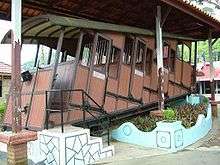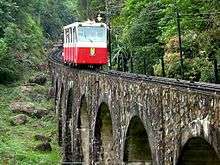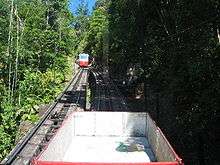Penang Hill Railway
The Penang Hill Railway is a one section funicular railway which climbs the Penang Hill from Air Itam, on the outskirts of the city of George Town in the Malaysian state of Penang. The railway first opened in 1923 as a two-section railway, and the system was overhauled in 2010. The total journey time can take between five and twenty minutes.[2][3] The funicular train coach travels directly from the lower station to the top, but may stop at other intermediate stations upon request.[4]
| Penang Hill Railway | |||||||||||||||||||||||||||||||||||||||||||||||||||||||||||||||||||||||||||||||||||
|---|---|---|---|---|---|---|---|---|---|---|---|---|---|---|---|---|---|---|---|---|---|---|---|---|---|---|---|---|---|---|---|---|---|---|---|---|---|---|---|---|---|---|---|---|---|---|---|---|---|---|---|---|---|---|---|---|---|---|---|---|---|---|---|---|---|---|---|---|---|---|---|---|---|---|---|---|---|---|---|---|---|---|---|
The Doppelmayr Garaventa 100-FUL Penang Hill coach at lower station. | |||||||||||||||||||||||||||||||||||||||||||||||||||||||||||||||||||||||||||||||||||
| Overview | |||||||||||||||||||||||||||||||||||||||||||||||||||||||||||||||||||||||||||||||||||
| Type | Funicular | ||||||||||||||||||||||||||||||||||||||||||||||||||||||||||||||||||||||||||||||||||
| Status | Operational | ||||||||||||||||||||||||||||||||||||||||||||||||||||||||||||||||||||||||||||||||||
| Locale | Penang Hill, Penang, Malaysia | ||||||||||||||||||||||||||||||||||||||||||||||||||||||||||||||||||||||||||||||||||
| Stations | 8 | ||||||||||||||||||||||||||||||||||||||||||||||||||||||||||||||||||||||||||||||||||
| Services | 2 | ||||||||||||||||||||||||||||||||||||||||||||||||||||||||||||||||||||||||||||||||||
| Website | www.penanghill.gov.my | ||||||||||||||||||||||||||||||||||||||||||||||||||||||||||||||||||||||||||||||||||
| Operation | |||||||||||||||||||||||||||||||||||||||||||||||||||||||||||||||||||||||||||||||||||
| Opened | October 21, 1923 | ||||||||||||||||||||||||||||||||||||||||||||||||||||||||||||||||||||||||||||||||||
| Operator(s) | Penang Hill Corporation (Perbadanan Bukit Bendera Pulau Pinang) | ||||||||||||||||||||||||||||||||||||||||||||||||||||||||||||||||||||||||||||||||||
| Rolling stock | 2 coaches of Doppelmayr Garaventa 100-FUL Penang Hill[1] | ||||||||||||||||||||||||||||||||||||||||||||||||||||||||||||||||||||||||||||||||||
| Technical | |||||||||||||||||||||||||||||||||||||||||||||||||||||||||||||||||||||||||||||||||||
| Track length | 1,996 metres (6,549 ft) | ||||||||||||||||||||||||||||||||||||||||||||||||||||||||||||||||||||||||||||||||||
| Track gauge | 1,000 mm (3 ft 3 3⁄8 in) | ||||||||||||||||||||||||||||||||||||||||||||||||||||||||||||||||||||||||||||||||||
| |||||||||||||||||||||||||||||||||||||||||||||||||||||||||||||||||||||||||||||||||||
History
Construction

The Penang Hill Railway was initially constructed for the British colonial community to enjoy the cooler air of the Penang Hill. The first attempt at a mountain railway on Penang Hill began with a proposal by three British residents, D. Logan, Joseph Heim and Alan Wilson and the formation of a private company in 1897, with funding from the colonial administration.[5] The first attempt used the steam engine and was not funicular, and it proved to be a failure. The line was constructed between 1901 and 1905, but did not work due to technical faults.[6]

In 1909, the Straits government organised a new project, the Penang Hills Funicular Railway.[6] This railway project was designed by Arnold R Johnson, an engineer with the Federated Malay States Railways, based on a Swiss design. Construction of the second railway cost 1.5 million Straits dollars. The 2,007m long funicular railway was informally opened on October 21, 1923 for the commencement of a trial operation.[7] After a successful trial period, on 1 January 1924, the railway was officially opened by the then Governor of Straits Settlement, Sir L.N. Guillemard.[6] In its first year of operation it carried 35,201 passengers and made 4,021 trips.[8] The Penang Municipality, George Town managed and maintained the railway from its opening until February 1, 1977, when it was taken over by the Penang state Government.[9]
Until 2010, the Penang Hills Funicular Railway had two independent sections due to the difference in gradient between the lower and upper section, and passengers were required to change train in the middle station. The upper and lower sections each had two counterbalanced 40-passenger cars, and each section had a passing loop in the middle and intermediate stops.[4] The cars were pulled by steel cable electrically driven with 500 volts power. The railway has a tunnel which measures 258 feet long and is the steepest tunnel in the world.[9] It took 30 minutes to go up the hill on the funicular service with a change of train in the middle station.[10]
1977 upgrade

The first carriages were wooden with defined first and second class compartments in each one. The four carriages were in use on the railway for over 50 years until they were retired in 1977 and replaced with the red carriages which had fans and automatic sliding doors. Each of the red Swiss-made carriages can hold up to 80 people, mostly standing.[11] They were in use for over 30 years until 2010.
2010 overhaul
After a series of breakdowns, the idea of a complete overhaul of the system with a new funicular railway was mooted. On 22 February 2010, the 87-year-old funicular railway was closed for an upgrade to a new system at a cost of RM63 million.[12][13] New tracks were laid, and new cars purchased to increase the passenger capacity and the speed of the train.[14] A new base station and a public carpark was also constructed.[15] The timber from the old railway track was re-used in the construction of a new four-storey Penang Hill Visitor Centre at the top.[16]
The new train and railway, unlike the railway before 2010, does not require passengers to change trains halfway up. Passengers can have non-stop service in the new blue and white, air-conditioned Swiss-made cars which are capable of ferrying up to 100 passengers at one go.[17][18] The funicular train maximum working load has been set at 7,500 kg.[19] It can carry 1,000 passengers per hour compared to 250 under the old system.[13]
On April 25, 2011, the new railway system resumed its service, although initially there were a number of technical hitches which caused the service to be temporarily suspended.[20] The train service runs from 6.30am to 9pm daily, and the new car can reach the top in as little as five minutes.[2][21] The upgrade led to a large increase in passengers carried; in 2014, the number of passengers reached 1.365 million,[22] compared to the visitors number to Penang Hill of around half a million in 2008.[23]
Stations
Visitors can enter the funicular railway at the Lower Station at Air Itam, and the final stop of the ride is the Upper Station at the top of Penang Hill. There are a number of stations along the railway between the Upper and Lower stations - the Middle Station (which is currently open only to residents), as well as the Claremont, Moniot Road, Viaduct, and the Lower and Upper Tunnel stations. Since the 2010 upgrade, the train normally proceeds directly to the top without stopping at the Middle Station. It is however possible to stop at some of the intermediate stations by arrangement with the driver.[24]
The Upper Station has been upgraded with the construction of an extended viewing platform named Skywalk, an elevated walkway leading to a food court, as well as a lift, a cafe and a museum gallery.[25][26] The Lower Station at Air Itam has been improved with a new building with retractable roof and a new multi-storey car park for visitors travelling by car.[27] Visitors can also reach the station on the 204 Rapid Penang bus from George Town, Penang.
Fares & tickets
For Malaysian citizens, the fare for a return ticket is RM12 per adult and RM6 per child aged between three and 12. Senior citizens will enjoy cheaper fares at RM6 per person. For non-Malaysian the fare is RM30 for adults and RM15 for children.[28]
The ride remains free of charge for disabled persons holding the OKU card.
Also unchanged are the fares for Penang Hill residents, licensed traders and hawkers and workers, who can purchase monthly season pass at RM24.
Technical parameters
.jpg)
1923-2010
Before 2010, the lower section of the funicular has the following technical parameters:[29]
- Length: 907 metres (2,976 ft)
- Height: 319 metres (1,047 ft)
- Maximum Steepness: 50.5%
- Cars: 2
- Capacity: 80 passengers per car
- Configuration: Single track with passing loop
- Journey time: 11 minutes
- Maximum speed: 1.4 metres per second (4.6 ft/s)
- Track gauge: 1,000 mm (3 ft 3 3⁄8 in)
- Traction: Electricity
The upper section of the funicular has the following technical parameters:[30]
- Length: 1,313 metres (4,308 ft)
- Height: 367 metres (1,204 ft)
- Maximum Steepness: 51.3%
- Cars: 2
- Capacity: 80 passengers per car
- Configuration: Single track with passing loop
- Journey time: 13 minutes
- Maximum speed: 1.8 metres per second (5.9 ft/s)
- Track gauge: 1,000 mm (3 ft 3 3⁄8 in)
- Traction: Electricity
After 2010
- Length: 1,996 metres (6,549 ft)
- Height: 691.4 metres (2,268 ft)
- Maximum slope: 52.9%, 27.9°
- Minimum slope: 18.8%, 10.7°
- Cars: 2
- Coach empty weight: 14,500 kg
- Maximum payload: 7,500 kg
- Capacity: 100 passengers per car
- Maximum speed: 10 metres per second (33 ft/s)
- Haul rope diameter: 38 mm
- Traction: Electricity
- Main drive motor: 710 kW
Gallery
- The 100-FUL Penang Hill new coach with view of the city in the background
 The 80-FUL Penang Hill old coach.
The 80-FUL Penang Hill old coach.- View of the railway from the lower station.
 Penang Hill Railway passing loop.
Penang Hill Railway passing loop. The end of the railway line at the Upper Station
The end of the railway line at the Upper Station
See also
- Awana Skyway - Aerial tramway type
- Genting Skyway - Gondola lift type
- Langkawi Cable Car - Gondola lift type
- Rail transport in Malaysia
References
- "Annual Brochure 2011". Doppelmayr Seilbahnen GmbH.
- "Up Penang Hill in five minutes". The Star Online. Archived from the original on March 21, 2011. Retrieved March 20, 2011.
- "A new joy ride up the hill". The Star Online. Archived from the original on March 27, 2012. Retrieved March 26, 2011.
- "Penang Hills Funicular Railway". Joe Thompson. Retrieved March 12, 2007.
- Joe Bindloss, Celeste Brash (2008). Kuala Lumpur, Melaka & Penang. Lonely Planet Publications. p. 202. ISBN 978-1741044850.
- "About us: Corporate Info". Archived from the original on 2015-04-22.
- "Railways". The Railway Magazine. 120-121: 385.
- Jin Seng Cheah (26 February 2013). Penang 500 Early Postcards. Editions Didier Millet. ISBN 978-9671061718.
- "Brief History Of Penang Hill Railway". Penang Hill with forestexplorers.com. Archived from the original on 2014-06-27. Retrieved 2015-04-29.
- "Penang Hill funicular trains to attract more tourists". The Star Online. Archived from the original on March 20, 2011. Retrieved March 19, 2011.
- "Penang hill railway Mad genius?". The Sunday Times. 24 May 1998.
- "A new chapter begins". allmalaysia.info. Archived from the original on February 12, 2013. Retrieved February 22, 2010.
- "New hill railway coaches ready for the ride". allmalaysia.info. Archived from the original on 26 February 2011. Retrieved August 20, 2010.
- "All set to soar uphill Handover of refurbished funicular train today". The Star Online. Archived from the original on October 17, 2012. Retrieved March 19, 2011.
- "Service to resume soon". The Star Online. Archived from the original on October 17, 2012. Retrieved March 29, 2011.
- Winnie Yeoh. "Railing for a new lease of life". The Star Online. Archived from the original on March 26, 2017. Retrieved March 26, 2011.
- "Slow or fast ride, that's the question now". The Star Online. Archived from the original on October 17, 2012. Retrieved March 26, 2011.
- "Penang Hill train service delayed". The Star Online. Archived from the original on October 17, 2012. Retrieved January 5, 2011.
- Hafiz Marzukhi (11 October 2014). "Penang Hill railway gets clean bill of health". Malay Mail.
- "Penang Hill train resumes service". The Star Online. Archived from the original on 28 July 2011. Retrieved 19 August 2011.
- "Mixed response to hill project". allmalaysia.info. Archived from the original on April 24, 2011. Retrieved May 18, 2009.
- Matthew Tan Kiak Hin (December 2015). "To the summit, anyone?". Penang Monthly.
- "Bukit Bendera visitors doubled last year". Astro Awani. January 8, 2013.
- Frances Wilks (December 21, 2012). "Penang's Hill Station". Expat Go.
- "Facilities coming up include museum gallery and cafe". The Star. February 9, 2015.
- Kae Min Goh (February 9, 2015). "Skywalk on Penang Hill to draw more visitors". The Malay Mail.
- Christopher Tan (January 20, 2015). "Lift glitch at new Penang Hill car park". The Star.
- "Ticket Fares". Penang Hill Inc. Archived from the original on 2015-04-23.
- "Penang Hill Railway (section 1)". Funiculars.net. Retrieved March 12, 2007.
- "Penang Hill Railway (section 2)". Funiculars.net. Retrieved March 12, 2007.
External links
| Wikimedia Commons has media related to Penang Hill Railway. |
- Penang Hill Railway official site
- The International Steam Pages Numerous images of The Penang Hill Railway before, after, and during the 2010 upgrade.
- Descent of the line on YouTube
- Ascent of the line on YouTube